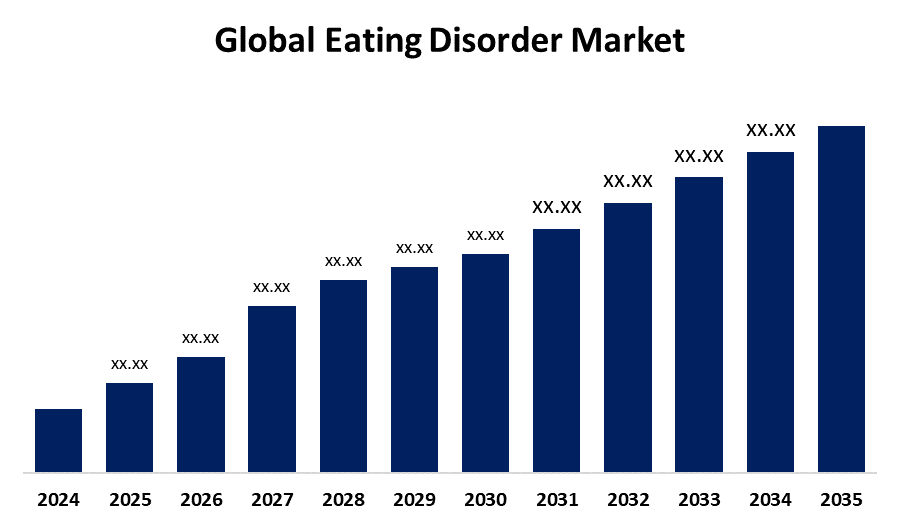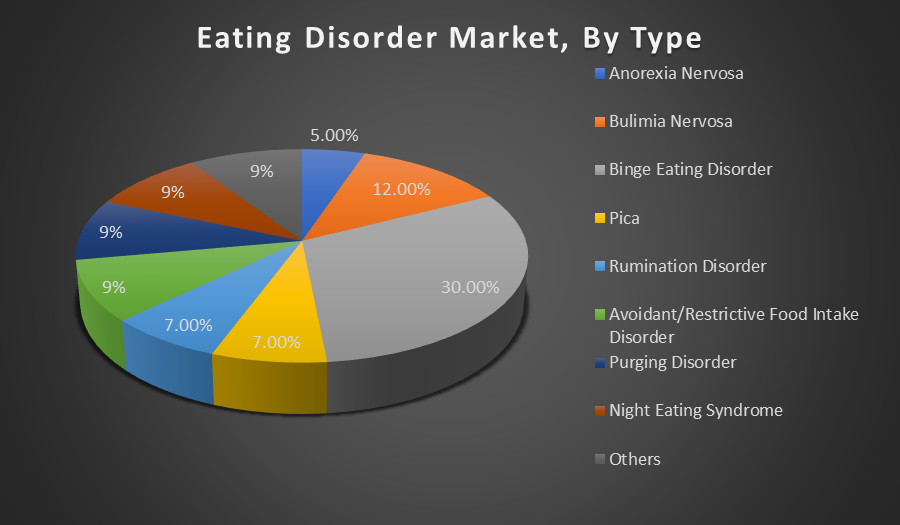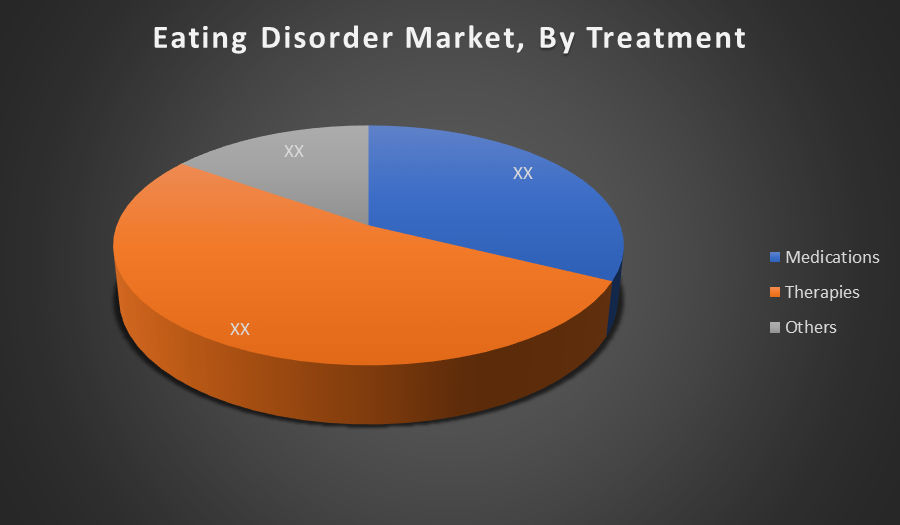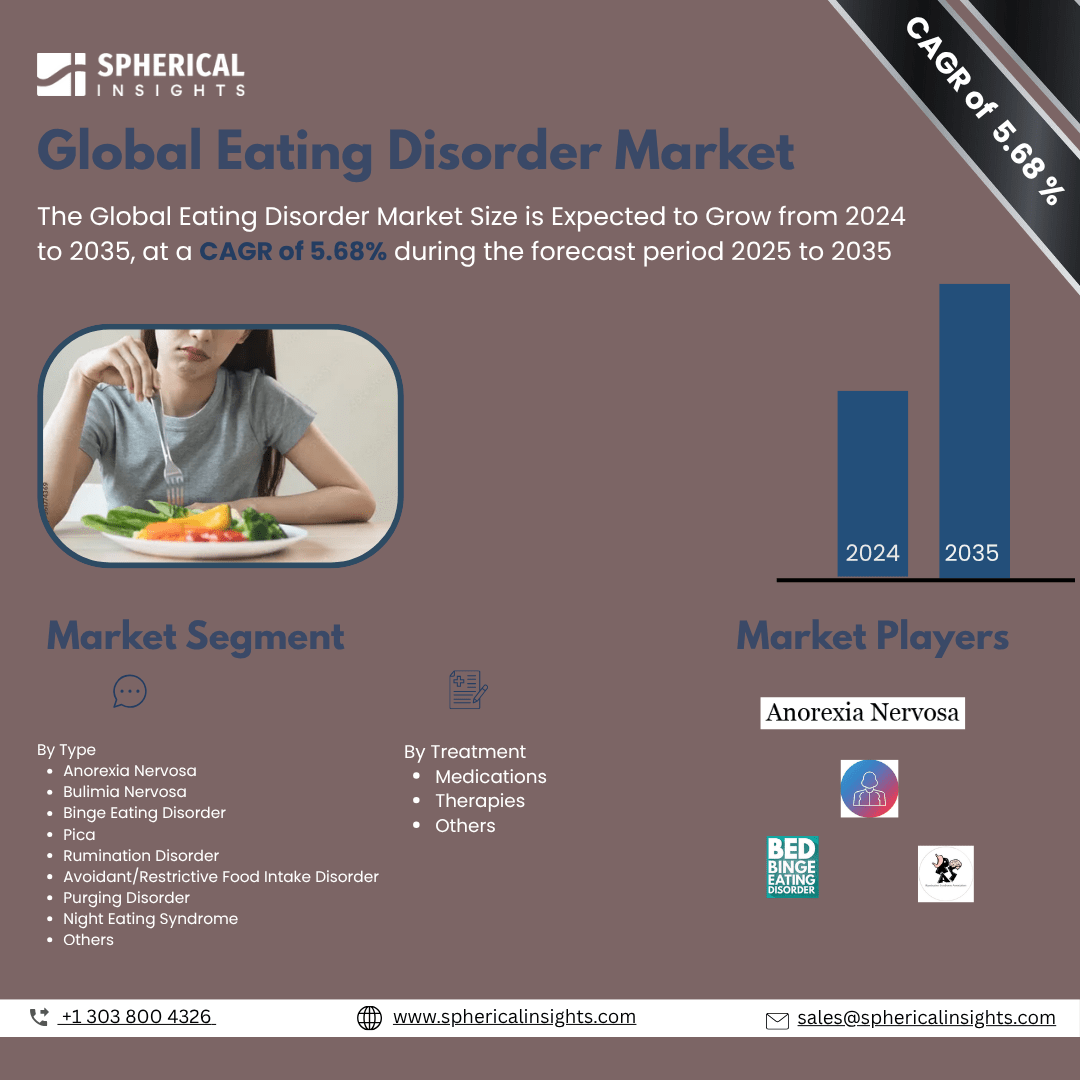- As per Spherical Insights & Consulting, The Global Eating Disorder Market Size is expected to grow from 2024 to 2035, at a CAGR of 5.68% during the forecast period 2025-2035, owing to the launch of new therapies in the market and the rise in the number of cases.
- The leading Eating Disorder Market Companies such as Pfizer, Eli Lilly and Company, GlaxoSmithKline, Johnson & Johnson, Allergan, Sun Pharmaceutical, Takeda Pharmaceutical, H. Lundbeck A/S, Otsuka Pharmaceutical, Alkermes, Bausch Health, Teva Pharmaceuticals, AstraZeneca, Sanofi, Neurocrine Biosciences, and Others.

Eating Disorder Treatment Market: Understanding and Treatment Algorithm:
Eating Disorder Market Size is a serious mental health condition characterized by abnormal eating habits that negatively impact physical and emotional well-being. It includes disorders like anorexia nervosa, bulimia nervosa, and binge-eating disorder, often driven by psychological, genetic, and environmental factors, requiring medical and therapeutic intervention for recovery.
Eating Disorder Diagnosis:
Diagnosis of Eating Disorders Market Size involves a comprehensive assessment of physical, psychological, and behavioural symptoms. Healthcare providers use clinical interviews, medical history, and standardized diagnostic criteria, such as the DSM-5, to identify specific disorders. Early and accurate diagnosis is crucial for effective treatment and improved patient outcomes.
Eating Disorder Treatment
Treatment of eating disorders typically combines medical management, nutritional counseling, and psychotherapy. Common approaches include cognitive-behavioural therapy, medications, and family-based therapy. Personalized treatment plans address both physical health and underlying psychological issues to support recovery and prevent relapse.
Eating Disorder Epidemiology
The disease epidemiology covered in the report provides historical as well as forecasted epidemiology segmented by Total Diagnosed Incident Population of Eating Disorder, Gender-specific Diagnosed Incidence of Eating Disorder, Type-specific Diagnosed Incidence of Eating Disorder, Age-specific Diagnosed Incidence of Eating Disorder, Diagnosed Incident Population based on Primary Site of Eating Disorder, and Diagnosed Incident Population based on Histologic Classification of Eating Disorder Tumour in the global market covering North America, Europe, Asia-Pacific, Latin America, the Middle East, and Africa from 2024 to 2035.
Principal Insights
This section offers a global overview of eating disorder epidemiology in major markets worldwide.
Country-Wise Eating Disorder Multiforme Epidemiology
- The epidemiology segment provides eating disorder prevalence data and findings across key regions worldwide, including North America, Europe (Germany, France, Italy, Spain, and the United Kingdom), Asia-Pacific (including Japan), Latin America, the Middle East, and Africa.
Eating Disorder Recent Developments:
- In June 2025, Azurity Pharmaceuticals received FDA approval for Arynta (lisdexamfetamine oral solution), making it the first liquid formulation of lisdexamfetamine. It was sanctioned to treat ADHD in individuals aged six and older, and moderate to severe binge-eating disorder in adults, offering an alternative for patients with difficulty swallowing solid medications.
Eating Disorder Marketed Drugs:
- Vyvanse: Takeda Pharmaceutical
Vyvanse (lisdexamfetamine dimesylate) is a central nervous system stimulant approved by the FDA for the treatment of moderate to severe binge-eating disorder (BED) in adults. It reduces the number of binge days per week by affecting dopamine and norepinephrine levels. Vyvanse is the first and only FDA-approved drug specifically for BED.
- Arynta: Azurity Pharmaceuticals
Arynta (lisdexamfetamine oral solution) is a newly FDA-approved liquid formulation of lisdexamfetamine used to treat binge-eating disorder in adults. It provides an alternative for patients who have difficulty swallowing capsules or tablets, maintaining the same efficacy as Vyvanse by targeting CNS pathways to control binge behaviors.
- Prozac: Eli Lilly and Company
Prozac (fluoxetine) is a selective serotonin reuptake inhibitor (SSRI) approved by the FDA for the treatment of bulimia nervosa. It helps reduce binge-eating and purging episodes by regulating serotonin levels in the brain. Prozac is one of the few medications specifically approved for an eating disorder.
Eating Disorder: Emerging Therapies
- TRP-8803: It is a novel psilocybin-based therapy in early clinical trials for binge-eating disorder. It utilizes a proprietary IV formulation of psilocin combined with psychotherapy to target rigid thought patterns and emotional dysregulation. The therapy aims to reduce binge frequency by modulating serotonin receptors and promoting cognitive flexibility.
- BMB-101: It is a selective 5-HT2C receptor agonist under preclinical development for binge-eating disorder. It aims to suppress appetite and binge behaviour by modulating serotonergic activity in the brain. Unlike older drugs, BMB-101 is designed to minimize off-target effects while enhancing safety and tolerability.
- TNX-1900: It is an intranasal formulation of oxytocin in clinical trials for eating disorders. It is being studied for its potential to reduce binge-eating episodes by influencing emotional regulation and satiety pathways in the hypothalamus. This novel delivery approach may improve adherence and offer a non-stimulant alternative.
- TACT-411: It is a selective serotonin transporter modulator in preclinical development aimed at treating anorexia nervosa and binge-eating disorder. By fine-tuning serotonin reuptake, it seeks to restore appetite control and reduce obsessive-compulsive behaviors associated with eating disorders.
Eating Disorder Market Outlook
- The eating disorder market includes diagnosis, treatment, and management of conditions like anorexia, bulimia, and binge-eating disorder. It encompasses pharmaceuticals, therapies, and digital health solutions aimed at improving patient outcomes and addressing growing mental health concerns worldwide.
- Rising prevalence of eating disorders, increasing mental health awareness, and growing healthcare infrastructure are key drivers. Additionally, advancements in treatment options and expanding insurance coverage boost patient access, fueling market growth across developed and emerging economies.
- Emerging therapies, increasing telehealth adoption, and rising demand for personalized treatment present significant opportunities. Untapped markets in Asia-Pacific and Latin America, along with government mental health initiatives, further drive investment and innovation in the eating disorder market.
- Governments worldwide are promoting mental health programs, funding research, and improving care accessibility. Awareness campaigns and integration of eating disorder screening in primary healthcare aim to reduce stigma and encourage early diagnosis and treatment.
- Stigma and a lack of standardized diagnosis limit patient access to timely care.
- The market is projected to grow robustly due to increasing prevalence and evolving treatment options addressing unmet clinical needs.
Eating Disorder Market Segmentation
By Type:
- Anorexia Nervosa
- Bulimia Nervosa
- Binge Eating Disorder
- Pica
- Rumination Disorder
- Avoidant/Restrictive Food Intake Disorder
- Purging Disorder
- Night Eating Syndrome,
- Others

Binge Eating Disorder holds the largest market share due to its high global prevalence, affecting people across all age groups. It is more commonly reported than other disorders, often linked to obesity and mental health issues, driving significant demand for treatment and research investments.
By Treatment:
- Medications
- Therapies
- Others

Therapies dominate the treatment segment as psychotherapy, especially Cognitive Behavioral Therapy (CBT), remains the most effective and widely adopted method for treating various eating disorders. The non-invasive nature, long-term benefits, and growing mental health awareness contribute to its widespread use over medications or other interventions.
Regional Segment Analysis of the Eating Disorder Market
North America holds the largest share of the global eating disorder market due to higher awareness, early diagnosis rates, and a well-established healthcare infrastructure. The presence of key market players and increasing mental health initiatives support market growth. Additionally, high treatment affordability and rising prevalence of conditions like binge eating and anorexia nervosa contribute to the region’s dominance in both treatment adoption and ongoing research into new therapeutic interventions.
Asia-Pacific is the fastest-growing region in the eating disorder market, driven by increasing awareness, urbanization, and changing lifestyle patterns. Rising stress levels, especially among adolescents and young adults, are contributing to higher incidence rates. Governments and healthcare organizations are also investing in mental health programs. As stigma around mental health reduces and access to care improves, the demand for both therapy and medication-based treatments is rising significantly across the region.
Eating Disorder Market Key Companies
- Pfizer
- Eli Lilly and Company
- GlaxoSmithKline
- Johnson & Johnson
- Allergan
- Sun Pharmaceutical
- Takeda Pharmaceutical
- H. Lundbeck A/S
- Otsuka Pharmaceutical
- Alkermes
- Bausch Health
- Teva Pharmaceuticals
- AstraZeneca
- Sanofi
- Neurocrine Biosciences
- Others
Eating Disorder Therapeutics Market Report Scope
- The Eating Disorder therapeutics market report provides a detailed overview, covering its causes, symptoms, disease progression, and existing treatment options.
- Detailed insights into Eating Disorder’s epidemiology and therapeutic approaches are included.
- Additionally, a comprehensive review of existing and emerging Eating Disorder therapies is provided, including an evaluation of new treatments expected to influence the current Eating Disorder treatment market landscape.
- The report includes a detailed review of the Eating Disorder therapeutics market, both historical and forecasted, highlighting the global drug reach.
- The Patient-Based Eating Disorder Market Forecasting report offers valuable insights into trends shaping the global Eating Disorder market, helping to develop effective business strategies.
Eating Disorder Treatment Market Report Insights
- Forecasting Market Trends Based on Patient Data and Disease Rates
- Eating Disorder Therapeutic Approaches in Eating Disorder
- Review Of Drugs in Development for Eating Disorder
- Market, Growth, and Trends in Eating Disorder
- Market Opportunities in Eating Disorder Treatment
- Effects Of Future Therapies on Eating Disorder Treatment.
Eating Disorder Treatment Market Report Key Strengths
- 15 Years Eating Disorder Market Forecast
- Global Coverage
- Eating Disorder Epidemiology Segmentation
- Key Cross Competition
Eating Disorder Treatment Market Report Assessment
- Present Practices in the Eating Disorder Treatment Market
- Review of Investigational Eating Disorder Drugs
- Attractiveness of the Eating Disorder Drug Market
- Eating Disorder Market Drivers
- Eating Disorder Market Barriers
- SWOT
- Attribute Analysis
Market Segment
This study forecasts revenue at the global, regional, and country levels from 2020 to 2035. Spherical Insights has segmented the eating disorder market based on the below-mentioned segments:
Global Eating Disorder Market, By Type
- Anorexia Nervosa
- Bulimia Nervosa
- Binge Eating Disorder
- Pica
- Rumination Disorder
- Avoidant/Restrictive Food Intake Disorder
- Purging Disorder
- Night Eating Syndrome
- Others
Global Eating Disorder Market, By Treatment
- Medications
- Therapies
- Others
Global Eating Disorder Market, By Regional Analysis
- North America
- Europe
- Germany
- UK
- France
- Italy
- Spain
- Russia
- Rest of Europe
- Asia Pacific
- China
- Japan
- India
- South Korea
- Australia
- Rest of Asia Pacific
- South America
- Brazil
- Argentina
- Rest of South America
- Middle East & Africa
- UAE
- Saudi Arabia
- Qatar
- South Africa
- Rest of the Middle East & Africa






